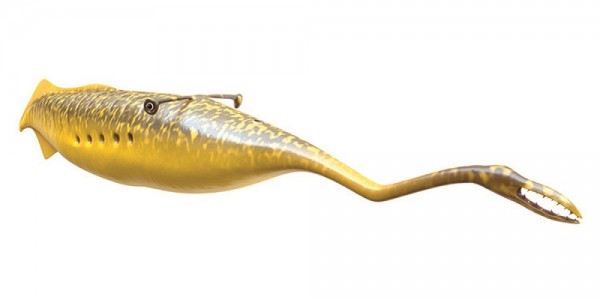By Ana Verayo, | March 17, 2016

The Tully Monster is apparently a vertebrate that is a close cousin of the modern day lampreys.
A bizarre prehistoric creature has been puzzling scientists, when an amateur fossil collector found the remains of a Tully Monster in Illinois back in 1958. This aquatic animal is shaped like a fat, long tube that possesses a long proboscis with a snout filled with tiny jaws and teeth.
Like Us on Facebook
The Tullimonstrum gregarium existed about 300 million years ago, with eyes similar to a snail's. Paleontologists are still not sure how to classify this creature, whether it is a worm, mollusk or a snail without its shell.
In this new study, scientists have analyzed over 2,000 specimens that are housed in the Field Museum in Chicago, where they finally determined where this monster fits in the animal kingdom.
The team from the museum are also composed of researchers from the Argonne National Laboratory and the American Museum of Natural History that is led by Victoria McCoy from Yale University, where their research reveals that this animal is a close cousin to the modern day lamprey.
According to McCoy, this research has been crucial in not just identifying the family of the Tully Monster from 300 million years ago, but it gives more insight about how most prehistoric animals are classified into major groups today. This also shows that modern lampreys originate from a more diverse ancient group of animals as researchers classify the Tully Monster as a stem lamprey, revealing a hidden diversity that existed in the group.
According to curator of invertebrate paleontology, Scott Lidgard of the Field Museum, this is a beautiful example of how science is working to solve the mysteries of nature and how museums step in.
The state of Illinois also made the Tully Monster its official state fossil in 1989 which is also considered as an important record in the field of science and paleontology. This certain species has been uncovered in Mazon Creek, some 90 miles southwest of Chicago, where the Tully Monster once thrived millions of years ago in the swampy area that bordered a tropical sea.
Lidgard describes that Mazon Creek was apparently home to a rich ecosystem during that period, however only a small fraction of the diverse creatures made it into the fossil records, as bones and shell also provided clues about prehistoric life. Apart from the Tully Monster, Mazon Creek also preserved a lot of insects and jellyfish as well.
This new study is published in the journal, Nature.
-
Use of Coronavirus Pandemic Drones Raises Privacy Concerns: Drones Spread Fear, Local Officials Say

-
Coronavirus Hampers The Delivery Of Lockheed Martin F-35 Stealth Fighters For 2020

-
Instagram Speeds Up Plans to Add Account Memorialization Feature Due to COVID-19 Deaths

-
NASA: Perseverance Plans to Bring 'Mars Rock' to Earth in 2031

-
600 Dead And 3,000 In The Hospital as Iranians Believed Drinking High-Concentrations of Alcohol Can Cure The Coronavirus

-
600 Dead And 3,000 In The Hospital as Iranians Believed Drinking High-Concentrations of Alcohol Can Cure The Coronavirus

-
COVID-19: Doctors, Nurses Use Virtual Reality to Learn New Skills in Treating Coronavirus Patients







